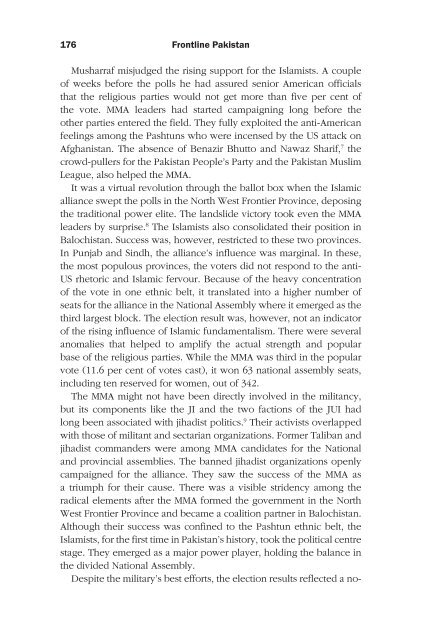Frontline Pakistan : The Struggle With Militant Islam - Arz-e-Pak
Frontline Pakistan : The Struggle With Militant Islam - Arz-e-Pak
Frontline Pakistan : The Struggle With Militant Islam - Arz-e-Pak
Create successful ePaper yourself
Turn your PDF publications into a flip-book with our unique Google optimized e-Paper software.
1 <strong>Frontline</strong> <strong><strong>Pak</strong>istan</strong><br />
Musharraf misjudged the rising support for the <strong>Islam</strong>ists. A couple<br />
of weeks before the polls he had assured senior American officials<br />
that the religious parties would not get more than five per cent of<br />
the vote. MMA leaders had started campaigning long before the<br />
other parties entered the field. <strong>The</strong>y fully exploited the anti-American<br />
feelings among the Pashtuns who were incensed by the US attack on<br />
Afghanistan. <strong>The</strong> absence of Benazir Bhutto and Nawaz Sharif, 7 the<br />
crowd-pullers for the <strong><strong>Pak</strong>istan</strong> People’s Party and the <strong><strong>Pak</strong>istan</strong> Muslim<br />
League, also helped the MMA.<br />
It was a virtual revolution through the ballot box when the <strong>Islam</strong>ic<br />
alliance swept the polls in the North West Frontier Province, deposing<br />
the traditional power elite. <strong>The</strong> landslide victory took even the MMA<br />
leaders by surprise. 8 <strong>The</strong> <strong>Islam</strong>ists also consolidated their position in<br />
Balochistan. Success was, however, restricted to these two provinces.<br />
In Punjab and Sindh, the alliance’s influence was marginal. In these,<br />
the most populous provinces, the voters did not respond to the anti-<br />
US rhetoric and <strong>Islam</strong>ic fervour. Because of the heavy concentration<br />
of the vote in one ethnic belt, it translated into a higher number of<br />
seats for the alliance in the National Assembly where it emerged as the<br />
third largest block. <strong>The</strong> election result was, however, not an indicator<br />
of the rising influence of <strong>Islam</strong>ic fundamentalism. <strong>The</strong>re were several<br />
anomalies that helped to amplify the actual strength and popular<br />
base of the religious parties. While the MMA was third in the popular<br />
vote (11.6 per cent of votes cast), it won 63 national assembly seats,<br />
including ten reserved for women, out of 342.<br />
<strong>The</strong> MMA might not have been directly involved in the militancy,<br />
but its components like the JI and the two factions of the JUI had<br />
long been associated with jihadist politics. 9 <strong>The</strong>ir activists overlapped<br />
with those of militant and sectarian organizations. Former Taliban and<br />
jihadist commanders were among MMA candidates for the National<br />
and provincial assemblies. <strong>The</strong> banned jihadist organizations openly<br />
campaigned for the alliance. <strong>The</strong>y saw the success of the MMA as<br />
a triumph for their cause. <strong>The</strong>re was a visible stridency among the<br />
radical elements after the MMA formed the government in the North<br />
West Frontier Province and became a coalition partner in Balochistan.<br />
Although their success was confined to the Pashtun ethnic belt, the<br />
<strong>Islam</strong>ists, for the first time in <strong><strong>Pak</strong>istan</strong>’s history, took the political centre<br />
stage. <strong>The</strong>y emerged as a major power player, holding the balance in<br />
the divided National Assembly.<br />
Despite the military’s best efforts, the election results reflected a no-













